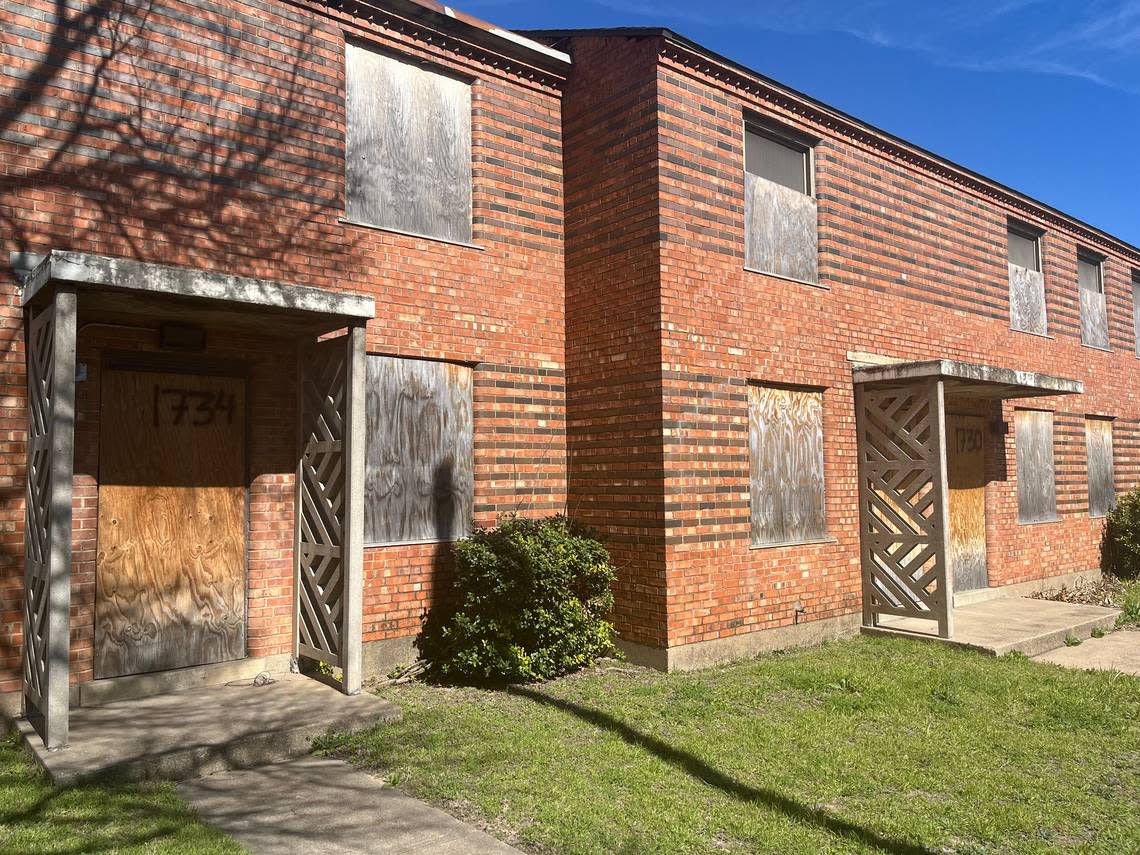Three Fort Worth buildings rich in Black history to be saved with historic designation
Three buildings of significance in Fort Worth’s African American history will be preserved under a new historic designation approved by a city commission.
The Historic Cultural and Landmarks Commission on Feb. 12 approved recognition as Historic and Cultural Landmarks for the buildings at 1715-1750 and 1801-1825 Stephenson St. in Butler Place and the former Carver-Hamilton Elementary School building, which is across the street from Butler Place at 1201 E. 13th St.
Such a designation preserves buildings from being demolished, provides a 10-year freeze on city property taxes and limits alterations to the properties.
Butler Place, though vacant, is Fort Worth’s oldest public housing complex. It is wedged on 42 acres of land between U.S. Highway 287, Interstate 35W and Interstate 30 on the east edge of downtown.
Rick Herring, chairman of the Historic and Cultural Landmarks Commission, was pleased to see the properties recommended for local historic designation.
“These two buildings and the Carver-Hamilton school will be the only remnants of a once thriving African American community that predated Butler Place and was destroyed by the freeways and everything else,” Herring said.
Criteria for historic designation
The Historic and Cultural designation status requires a property to meet criteria for historical significance and structural integrity as laid out by the city’s historic preservation ordinance.
A staff report from the Historic and Cultural Landmarks Commission stated the properties are “consistent” with the requirements of the historic preservation ordinance and recommended that the Historic Cultural and Landmarks Commission recommend to the City Council that the buildings be considered for recognition as Historic and Cultural Landmarks.
The former school is associated with the African American community and the “development of increasing access to public schools for African American students,” according to the staff report.
The school was built in 1909 as the Fort Worth Colored High School. It was the largest public school and first free public school for African Americans in Fort Worth. It was later named I.M. Terrell High School in 1921 until I.M. Terrell moved to its current location at 1900 I.M. Terrell Way as I.M. Terrell Academy for STEM and VPA. The original building was renamed to Carver-Hamilton, and was an elementary school and middle school. In 1995, Fort Worth Housing Solutions bought the building and used it as its headquarters until 2022.
Butler Place was one of 52 Works Progress Administration projects for low-income housing under President Franklin D. Roosevelt’s New Deal. It is associated with housing African American residents and the “development of social housing within Fort Worth” after the Great Depression, according to the staff report.

The housing project has over 400 units but in December 2020 the last families left with help from the federal Department of Housing and Urban Development’s Rental Assistance Demonstration program. The program helped move residents while maintaining their housing assistance as part of a strategy to de-concentrate poverty by providing affordable housing throughout the city.
It was listed on the National Register of Historic Places in 2011. The National Historic Preservation Act provides a framework to identify and protect historical landmarks that would be affected by federal projects.
The future of Butler Place
A committee was formed in 2016 to figure out strategies for historic preservation and potential uses for Butler Place.
The remaining property will be demolished for redevelopment for potential uses such as offices, housing or a campus for higher education.
Fort Worth Housing Solutions, the owner of the properties, with the help of Fort Worth’s historic preservation department, the Tarrant County Black Historical & Genealogical Society and other stakeholders helped write a list of mitigation steps to retain the historical relevance of Butler Place and Carver-Hamilton before redevelopment occurs.
These include the construction of an amphitheater, applying for an Historic and Cultural Landmarks designation for the former Carver-Hamilton Elementary School building, developing interpretive signage regarding the history of public housing in Fort Worth, and saving a minimum of 1,000 bricks from the Butler Place property. A video history and a collection of historical photos of Butler Place have already been created.
Jerre Tracy is the executive director of Historic Fort Worth, which has a mission to preserve, educate, and promote the historical significance of buildings in Fort Worth.
Butler Place was one of two Works Progress Administration projects in Fort Worth, the other being Ripley Arnold Place, which was originally for white families and was demolished in 2003. They were designed by the best architects of that day, including Wiley G. Clarkson, designer of the Texas Christian University Library, and a local architecture firm, Waller, Shaw, and Field, which designed the R. Vickery School.
The proximity of Butler Place, Carver-Hamilton Elementary School building, I.M. Terrell High School, and association with Dee Jennings, the former CEO of the Fort Worth Metropolitan Black Chamber, who grew up in Butler Place, are the last remains of the African American heritage in that area, Tracy says.
“Preservation has been very slow to get the educational under-footing it has deserved because it’s so interesting once you figure it out,” Tracy said. “It’s so really interesting to connect people with buildings and places.”
